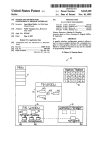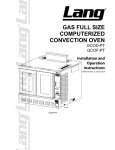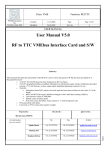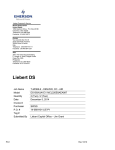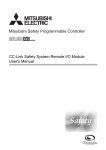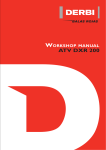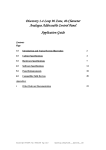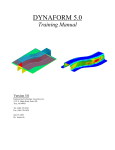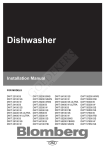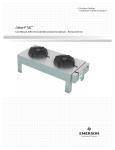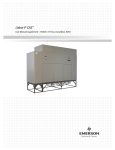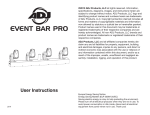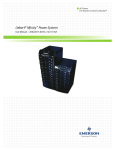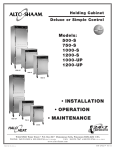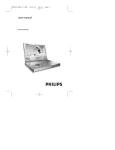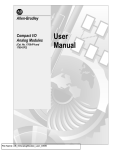Download Liebert® EconoPhase - Emerson Network Power
Transcript
Liebert® EconoPhase™ User Manual - 85kW (24 Tons),125kW (35 Tons), 50Hz and 60Hz TABLE OF CONTENTS IMPORTANT SAFETY INSTRUCTIONS . . . . . . . . . . . . . . . . . . . . . . . . . . . . . . . . . . . . . . . . . .1 1.0 MODEL NUMBER NOMENCLATURE AND SPECIFICATIONS . . . . . . . . . . . . . . . . . . . . . . . . . . .3 2.0 LIEBERT DSE™ SYSTEM DESCRIPTION . . . . . . . . . . . . . . . . . . . . . . . . . . . . . . . . . . . . . . . .4 2.1 Liebert DSE . . . . . . . . . . . . . . . . . . . . . . . . . . . . . . . . . . . . . . . . . . . . . . . . . . . . . . . . . . . . . . . . 4 2.2 Liebert DSE™ . . . . . . . . . . . . . . . . . . . . . . . . . . . . . . . . . . . . . . . . . . . . . . . . . . . . . . . . . . . . . . . 5 2.3 Liebert MC™ . . . . . . . . . . . . . . . . . . . . . . . . . . . . . . . . . . . . . . . . . . . . . . . . . . . . . . . . . . . . . . . . 6 2.4 Liebert EconoPhase . . . . . . . . . . . . . . . . . . . . . . . . . . . . . . . . . . . . . . . . . . . . . . . . . . . . . . . . . . 7 2.5 Standard Air-Cooled System vs. Liebert EconoPhase System . . . . . . . . . . . . . . . . . . . . . . . . 8 2.6 Operating Modes . . . . . . . . . . . . . . . . . . . . . . . . . . . . . . . . . . . . . . . . . . . . . . . . . . . . . . . . . . . . 8 2.7 Module Communications . . . . . . . . . . . . . . . . . . . . . . . . . . . . . . . . . . . . . . . . . . . . . . . . . . . . . 10 3.0 DESCRIPTION OF LIEBERT ECONOPHASE OPERATION . . . . . . . . . . . . . . . . . . . . . . . . . . . .12 3.1 EconoPhase Control . . . . . . . . . . . . . . . . . . . . . . . . . . . . . . . . . . . . . . . . . . . . . . . . . . . . . . . . . 12 3.1.1 3.1.2 3.1.3 Room Temperature . . . . . . . . . . . . . . . . . . . . . . . . . . . . . . . . . . . . . . . . . . . . . . . . . . . . . . . . . . . 12 Refrigerant Temperature . . . . . . . . . . . . . . . . . . . . . . . . . . . . . . . . . . . . . . . . . . . . . . . . . . . . . . 14 Pump Pressure Differential . . . . . . . . . . . . . . . . . . . . . . . . . . . . . . . . . . . . . . . . . . . . . . . . . . . . 14 3.2 Pump Startup Routine . . . . . . . . . . . . . . . . . . . . . . . . . . . . . . . . . . . . . . . . . . . . . . . . . . . . . . . 14 3.3 Switch from Compressor Operation to Pump Operation . . . . . . . . . . . . . . . . . . . . . . . . . . . . 14 3.4 Switch from Pump Operation to Compressor Operation . . . . . . . . . . . . . . . . . . . . . . . . . . . . 15 3.5 Loop Temperatures . . . . . . . . . . . . . . . . . . . . . . . . . . . . . . . . . . . . . . . . . . . . . . . . . . . . . . . . . 15 3.6 Mechanical Considerations . . . . . . . . . . . . . . . . . . . . . . . . . . . . . . . . . . . . . . . . . . . . . . . . . . . 15 4.0 INSTALLATION . . . . . . . . . . . . . . . . . . . . . . . . . . . . . . . . . . . . . . . . . . . . . . . . . . . . . . . . . 16 4.1 Unpacking and Moving the Liebert EconoPhase . . . . . . . . . . . . . . . . . . . . . . . . . . . . . . . . . . 16 4.2 Liebert EconoPhase Dimensions and Weights . . . . . . . . . . . . . . . . . . . . . . . . . . . . . . . . . . . . 19 4.3 Determine Cooling Requirements of the Liebert EconoPhase System . . . . . . . . . . . . . . . . . 20 4.4 Placement Options and Piping Restrictions for the Liebert EconoPhase and Air-Cooled Condenser . . . . . . . . . . . . . . . . . . . . . . . . . . . . . . . . . . . . . . . . . . . . . . . . . . . . . . . . . . . . . . . . . 20 4.5 Line Sizing in a Liebert EconoPhase System . . . . . . . . . . . . . . . . . . . . . . . . . . . . . . . . . . . . . 21 4.6 Piping Schematics . . . . . . . . . . . . . . . . . . . . . . . . . . . . . . . . . . . . . . . . . . . . . . . . . . . . . . . . . . 22 4.7 System Charging . . . . . . . . . . . . . . . . . . . . . . . . . . . . . . . . . . . . . . . . . . . . . . . . . . . . . . . . . . . 25 4.8 Electrical Connections . . . . . . . . . . . . . . . . . . . . . . . . . . . . . . . . . . . . . . . . . . . . . . . . . . . . . . . 26 4.8.1 5.0 Variable Speed Drive . . . . . . . . . . . . . . . . . . . . . . . . . . . . . . . . . . . . . . . . . . . . . . . . . . . . . . . . . 28 TROUBLESHOOTING . . . . . . . . . . . . . . . . . . . . . . . . . . . . . . . . . . . . . . . . . . . . . . . . . . . . . 30 i FIGURES Figure 1 Figure 2 Figure 3 Figure 4 Figure 5 Figure 6 Figure 7 Figure 8 Figure 9 Figure 10 Figure 11 Figure 12 Figure 13 Figure 14 Figure 15 Figure 16 Figure 17 Figure 18 Figure 19 Figure 20 Figure 21 Pressure enthalpy diagram, pumped refrigerant Liebert EconoPhase . . . . . . . . . . . . . . . . . . . . . . 4 Liebert DSE indoor unit . . . . . . . . . . . . . . . . . . . . . . . . . . . . . . . . . . . . . . . . . . . . . . . . . . . . . . . . . . . 5 Liebert MC™ air -cooled microchannel condenser . . . . . . . . . . . . . . . . . . . . . . . . . . . . . . . . . . . . . . 6 Liebert EconoPhase module . . . . . . . . . . . . . . . . . . . . . . . . . . . . . . . . . . . . . . . . . . . . . . . . . . . . . . . . 7 Compressorized operation flow path . . . . . . . . . . . . . . . . . . . . . . . . . . . . . . . . . . . . . . . . . . . . . . . . . 9 Pump operation flow path . . . . . . . . . . . . . . . . . . . . . . . . . . . . . . . . . . . . . . . . . . . . . . . . . . . . . . . . . 9 CANbus connections . . . . . . . . . . . . . . . . . . . . . . . . . . . . . . . . . . . . . . . . . . . . . . . . . . . . . . . . . . . . . 11 Two-circuit pump control . . . . . . . . . . . . . . . . . . . . . . . . . . . . . . . . . . . . . . . . . . . . . . . . . . . . . . . . . 13 Removing the shipping crate . . . . . . . . . . . . . . . . . . . . . . . . . . . . . . . . . . . . . . . . . . . . . . . . . . . . . . 17 Removing screws securing Liebert EconoPhase to skid . . . . . . . . . . . . . . . . . . . . . . . . . . . . . . . . . 17 Typical sling arrangement for lifting unit . . . . . . . . . . . . . . . . . . . . . . . . . . . . . . . . . . . . . . . . . . . . 18 Liebert EconoPhase typical unit dimensional drawing . . . . . . . . . . . . . . . . . . . . . . . . . . . . . . . . . 19 Relative heights of condenser and Liebert EconoPhase . . . . . . . . . . . . . . . . . . . . . . . . . . . . . . . . . 20 Piping Schematic—air-cooled Liebert DA 125/150 models with Liebert EconoPhase . . . . . . . . . 22 Piping Schematic—air-cooled Liebert DA 080/085 models with Liebert EconoPhase . . . . . . . . . 23 Typical unit arrangement diagram . . . . . . . . . . . . . . . . . . . . . . . . . . . . . . . . . . . . . . . . . . . . . . . . . 24 Typical general arrangement diagram . . . . . . . . . . . . . . . . . . . . . . . . . . . . . . . . . . . . . . . . . . . . . . 25 Typical field electrical connection . . . . . . . . . . . . . . . . . . . . . . . . . . . . . . . . . . . . . . . . . . . . . . . . . . 27 Wye-connected power diagram. . . . . . . . . . . . . . . . . . . . . . . . . . . . . . . . . . . . . . . . . . . . . . . . . . . . . 28 Delta-connected power diagram . . . . . . . . . . . . . . . . . . . . . . . . . . . . . . . . . . . . . . . . . . . . . . . . . . . . 29 Disconnecting EMC filter for operation with Delta-connected power . . . . . . . . . . . . . . . . . . . . . . 29 TABLES Table 1 Table 2 Table 3 Table 4 Table 5 Table 6 Table 7 Table 8 Liebert EconoPhase specifications . . . . . . . . . . . . . . . . . . . . . . . . . . . . . . . . . . . . . . . . . . . . . . . . . . . 3 Description of events and actions in Figure 8 . . . . . . . . . . . . . . . . . . . . . . . . . . . . . . . . . . . . . . . . 13 Representative Liebert EconoPhase loop temperatures at 35°F (1.6°C) outdoor temperature . . 15 Field piping restrictions between air-cooled condenser and Liebert EconoPhase. . . . . . . . . . . . . 20 Condenser height restrictions relative to Liebert DSE . . . . . . . . . . . . . . . . . . . . . . . . . . . . . . . . . 20 Line sizing for Liebert DSE™ / Liebert EconoPhase System . . . . . . . . . . . . . . . . . . . . . . . . . . . . . 21 Liebert EconoPhase module charge . . . . . . . . . . . . . . . . . . . . . . . . . . . . . . . . . . . . . . . . . . . . . . . . . 25 List of alarms and possible causes . . . . . . . . . . . . . . . . . . . . . . . . . . . . . . . . . . . . . . . . . . . . . . . . . . 30 ii IMPORTANT SAFETY INSTRUCTIONS IMPORTANT SAFETY INSTRUCTIONS SAVE THESE INSTRUCTIONS This manual contains important safety instructions that must be followed during the installation and maintenance of the Liebert EconoPhase Pumped Refrigerant Economizer. Read this manual thoroughly before attempting to move, lift, remove packaging from, install, operate or perform maintenance on this unit. Only qualified personnel should move, lift, remove packaging from, install or service this equipment. Adhere to all warnings, cautions and installation, operating and safety instructions on the unit and in this manual. Follow all operating and user instructions. ! WARNING Risk of electric shock. Can cause injury or death. Open all local and remote electric power disconnect switches and verify that power is Off with a voltmeter before working within the electrical connection enclosures or making any electrical connections. Before proceeding with installation, read all instructions, verify that all the parts are included and check the nameplate to be sure the voltage matches available utility power. Follow all local codes. ! WARNING Arc flash and electric shock hazard. Can cause injury or death. Open all local and remote electric power disconnect switches, verify that power is Off with a voltmeter and wear appropriate personal protective equipment per NFPA 70E before working within the electrical control enclosure. Customer must provide earth ground to unit, per NEC, CEC and local codes, as applicable. Before proceeding with installation, read all instructions, verify that all the parts are included and check the nameplate to be sure the voltage matches available utility power. Follow all appropriate national and local codes. Reinstall all terminal covers before connecting power to the unit. Failure to install these covers exposes high-voltage terminals. ! WARNING Risk of electric shock from leakage current. Can cause injury or death. Reconnect earth ground if servicing or replacing the variable speed drive (VSD). ! WARNING Risk of explosive discharge from high-pressure refrigerant. Can cause injury or death. This unit contains fluids and gases under high pressure. Relieve pressure before cutting into or working with piping. ! WARNING Risk of refrigerant system rupture or explosion. Can cause equipment damage, injury or death. Do not pressurize the refrigerant system higher than the Design Pressure rating marked on the unit nameplate. Wear appropriate personal protective equipment and monitor the pressure with accurately calibrated pressure gauges during the system charging operation. For systems requiring EU CE compliance (50Hz), the system installer must provide and install a discharge pressure relief valve rated for a maximum of 650 psig (45 bar) in the high side refrigerant circuit. The pressure relief valve must be CE-certified to the EU Pressure Equipment Directive by an EU “Notified Body.” ! WARNING Risk of improper wiring, piping, moving, lifting and handling. Can cause equipment damage, injury or death. Installation and service of this equipment should be done only by qualified personnel who have been specially trained in the installation of Emerson Thermal Management equipment. Liebert® EconoPhase™ 1 IMPORTANT SAFETY INSTRUCTIONS ! CAUTION Risk of handling heavy unit and component parts. Can cause injury and equipment damage. Use OSHA recommended safe lifting techniques and/or lifting equipment rated for the weight of the unit. See Table 1 of this manual for unit weight. ! CAUTION Risk of contact with hot surfaces. Can cause injury. The pumps and refrigerant discharge lines are extremely hot during unit operation. Allow sufficient time for them to cool before working within the unit cabinet. Use extreme caution and wear protective gloves and arm protection when working on or near hot pumps and refrigerant lines. ! CAUTION Risk of sharp edges, splinters and exposed fasteners. Can cause injury. Only properly trained and qualified personnel wearing appropriate safety headgear, gloves, shoes and glasses should attempt to move, lift or remove packaging from the unit. ! CAUTION Risk of electric shock and short circuits. Can cause equipment damage, injury or death. Insert CSA certified or UL listed bushings into holes and or knockouts used to route wiring through to protect the wire insulation from contact with sheet metal edges. NOTICE Risk of excessive oxidation and scale formation on interior piping surfaces. Can cause equipment damage. During brazing, the refrigerant lines must be filled with flowing dry nitrogen to prevent excessive oxidation and scale formation inside the piping. Use currently documented and accepted good refrigeration practices for piping supports, leak testing, dehydration and charging. Failure to use good system practices may result in damage to the system. Refer to the most currently published ASHRAE refrigeration handbook for documented good practice refrigeration piping guidelines. NOTICE Risk of improper electrical connection of three-phase input power. Can cause unit damage. Service technicians should use a gauge set during the initial startup to verify that the three-phase power is connected properly. NOTICE Risk of overheated terminals. Can cause wiring and component damage. Use copper wiring only. Make sure that all connections are tight. NOTICE Risk of improper program adjustment. Can cause equipment damage and loss of warranty. The VSD is factory-programmed for proper operation. Altering the VSD program without authorization from the factory may void the warranty. NOTICE Risk of mismatched input power supply and VSD requirements. May cause equipment damage and failure. The EMC filter must be removed from the VSD if the power supply is Delta-connected. NOTICE Risk of improper forklift operation. Can cause equipment damage. Keep the forklift’s tines level and at a height suitable to fit below the skid and/or unit to prevent exterior and/or underside damage. 2 Liebert® EconoPhase™ Model Number Nomenclature and Specifications 1.0 MODEL NUMBER NOMENCLATURE AND SPECIFICATIONS Example: PR125AA6DD-* PR 125 A Nominal Cooling Capacity, kW 6 D D Pump Configuration S = Single D = Dual A = 460V, 60Hz B = 575V, 60Hz E = 416V, 3 Phase, 60Hz G = 415V, 3 Phase, 50Hz Y = 208/230V, 60Hz 2 = 380/400V, 3 Phase, 60Hz Disconnect Switch, Amperage 5 = 5,000 Amp SCCR 6 = 65,000 Amp SCCR A = Air-Cooled Heat Rejection Liebert Pumped Refrigerant Economizer System Table 1 A — * Placeholder Packaging D = Domestic E = Export Crating Revision Level Pump Motor Weight, lb (kg) Liebert EconoPhase specifications Electrical Specifications Voltage Phase Hz FLA Minimum Supply Circuit Ampacity PR125AA*** PR085AA*** 460 3 60 7.0 7.9 15 1.6 3.5 340 (154) 478 (217) PR125AY*** PR085AY*** 208/230 3 60 13.8 15.5 20 1.6 6.9 340 (154) 478 (217) 575 3 60 5.6 6.3 15 1.6 3.5 390 (177) 528 (240) PR125A2*** PR085A2*** 380/400 3 60 8.4 9.4 15 1.6 3.5 390 (177) 528 (240) PR125AG*** PR085AG*** 415 3 50 7.4 8.3 15 1.6 3.7 347 (157) 578 (262) Model PR125AB*** PR085ABA*** FLA = Full Load Amps Liebert® EconoPhase™ 3 Maximum Fuse Size HP FLA Unit Shipping Liebert DSE™ System Description 2.0 LIEBERT DSE™ SYSTEM DESCRIPTION 2.1 Liebert DSE Liebert DSE systems are designed to provide precision air conditioning to computer racks in a data center or computer room as efficiently and effectively as possible. A Liebert DSE system with Liebert EconoPhase is composed of: • Liebert DSE—High efficiency, floor-mounted indoor unit • Liebert MC™ Condenser—Air-cooled microchannel condenser, premium version • Liebert EconoPhase—Liebert EconoPhase module The Liebert EconoPhase is an add-on module for use with an air-cooled Liebert DSE system. The Liebert EconoPhase will allow the system to switch to Liebert EconoPhase operation when the outdoor temperature is low enough to provide the required temperature difference between the inside air and the outside air, providing significant energy savings because there is no need to operate the compressor. At lower temperatures, the system switches one or both circuits from Compressor Mode to Pump Mode. The pump consumes roughly 1/10th of the power consumed by the compressor. The Liebert EconoPhase system maintains this energy efficiency by employing the heat absorption properties of a liquid (pumped refrigerant) through a phase change. Refrigerant is pumped as a liquid, becomes a gas within the Liebert DSE evaporator and then is returned to the Liebert MC where it condenses to a liquid. The subcooled liquid refrigerant from the condenser is then run directly into the Liebert EconoPhase pumps and is circulated back to the Liebert DSE unit (see Figure 1). The system will operate as a typical air-cooled direct expansion system when outdoor ambient conditions are unfavorable to EconoPhase operation. The pumps in the Liebert EconoPhase pump module are turned off and bypassed during compressor operation. Figure 1 Pressure enthalpy diagram, pumped refrigerant Liebert EconoPhase Liquid Liquid/Vapor Mix Vapor Condenser (DX Mode) Pressure Indoor Unit Condenser (Pump Mode) Tradtional Vapor Compression Cycle EconoPhase Cycle Enthalpy 4 Liebert® EconoPhase™ Liebert DSE™ System Description 2.2 Liebert DSE™ The Liebert DSE indoor unit (Figure 2) is a high-efficiency room-based Precision Cooling module designed to provide the airflow, air temperature and humidity required for reliable data center operation. Components contributing to the high-efficiency operation include Liebert iCOM® monitoring and control system, tandem scroll compressors, fin-and-tube evaporator coil, variable speed EC plug fans and electronic expansion valves. The Liebert DSE exceeds ASHRAE 90.1 standards for energy efficiency. Figure 2 Liebert DSE indoor unit Liebert® EconoPhase™ 5 Liebert DSE™ System Description 2.3 Liebert MC™ The Liebert MC air-cooled microchannel condenser (Figure 3) is a low-profile, direct-drive propeller fan-type air-cooled unit suitable for mounting outdoors. It provides heat rejection for either one or two separate refrigeration circuits, matches the heat rejection capacity corresponding with the outdoor ambient temperature and with each corresponding compressor heat rejection requirements. Constructed with an aluminum cabinet, galvanized steel frame and microchannel coil, the unit is quiet and corrosion resistant. The condenser is quickly and easily installed because all internal wiring is completed at the factory with only electrical connections and communications connections to be made at the job site. All electrical connections and controls are enclosed in an integral weatherproof section of the condenser. The Liebert EconoPhase pumped refrigerant system will always use the premium version condenser. In EconoPhase operation, the premium control board uses inputs from the indoor unit, condenser refrigerant temperatures and ambient temperatures to modulate the EC fan motor speed from 0 to 100% RPM, maintaining the refrigerant temperature setpoint. The control system provides temperature control for outdoor ambient as low as -40°F (-40°C) in pumped refrigerant Liebert EconoPhase operation. Figure 3 Liebert MC™ air -cooled microchannel condenser 6 Liebert® EconoPhase™ Liebert DSE™ System Description 2.4 Liebert EconoPhase The Liebert EconoPhase is an option for a Liebert DSE™ air-cooled system. The Liebert EconoPhase allows an air-cooled direct expansion system to switch from vapor compression operation to pumped refrigerant operation when the outdoor temperature is low enough to provide the required temperature difference between the inside air and the outside air. Figure 4 Liebert EconoPhase module Liebert® EconoPhase™ 7 Liebert DSE™ System Description 2.5 Standard Air-Cooled System vs. Liebert EconoPhase System There are differences between the standard air-cooled Liebert DSE™ system and a system designed with the Liebert EconoPhase. The user must be aware of these differences to achieve the best operation the Liebert DSE and Liebert EconoPhase. This section summarizes the differences; more detailed explanations are found throughout this manual. • Liebert EconoPhase Operation—Liebert EconoPhase operation is possible when the outdoor temperature is low enough to provide the required temperature difference between the indoor air and the outside air. This mode turns the compressors Off and turns the Liebert EconoPhase pumps On. • Refrigerant Pumping—During Liebert EconoPhase operation, the refrigerant is pumped around the air-cooled loop instead of going through the vapor compression cycle. System pressures will vary significantly depending on whether the system is operating in standard aircooled mode or in Liebert EconoPhase operation. • Energy Savings—The coefficient of performance of the system increases significantly during the EconoPhase operation which results in significant energy savings for the user. • EEV—The system uses an electronic expansion valve during both direct expansion and EconoPhase operation. The EEV results in energy savings and helps the pump maintain proper differential during EconoPhase operation. • Piping—The condenser piping is larger than what is typically specified for Liebert air-cooled Precision Cooling systems. The pipe sizing still allows oil return to the compressor and also allows for efficient operation in both modes of operation. All field piped lines must be insulated because the fluid temperatures can be well below the dew point during EconoPhase operation. All outdoor insulation must be UV rated and rated for outdoor use. • Unit/Module Communications—A CANbus connection links the Liebert DSE and the air-cooled condenser to achieve the most efficient operation as well as the condenser and the Liebert EconoPhase module. 2.6 Operating Modes Each circuit on a system combining a Liebert EconoPhase, Liebert DSE and Liebert MC has six distinct operating modes: • • • • • • Idling with compressor and pumps Off Startup Compressor operation Compressor-to-pump changeover Pump operation Pump-to-compressor changeover A circuit will run most of the time in either compressor or pump operation mode. These modes both efficiently remove heat from the conditioned space and reject it via the air-cooled condenser. The flow paths during each mode of operation are detailed in Figures 5 and 6. A couple of differences to note between Compressor Mode and Liebert EconoPhase operation: • The unit does not dehumidify in Liebert EconoPhase operation. If dehumidification is desired, Liebert EconoPhase operation must be disabled. • Bubbles may be seen in the site glass in the indoor unit when the system is in Liebert EconoPhase operation. This does not necessarily mean the system is low on charge. Refer to the Liebert DSE™ user manual (SL-18925) for complete charging instructions for the Liebert DSE/Liebert EconoPhase system. 8 Liebert® EconoPhase™ Liebert DSE™ System Description Figure 5 Compressorized operation flow path Check Valve Condenser Solenoid Valve Pump Check Valve Electronic Expansion Valve Check Valve Compressor Evaporator Figure 6 Pump operation flow path Check Valve Condenser Solenoid Valve Pump Check Valve Electronic Expansion Valve Check Valve Evaporator Liebert® EconoPhase™ 9 Compressor Liebert DSE™ System Description 2.7 Module Communications The Liebert DSE™ (Deluxe Advanced system), Liebert MC™ (microchannel condenser) and Liebert EconoPhase (Pumped Refrigerant Economizer) require communication when combined into a system. This is done through a CANbus communication interface. A CANbus cable must be connected from the Liebert DSE at the designated terminal(s) to TB49 on the Liebert MC condenser board (refer to the Liebert DSE user manual, SL-18925). If there is an additional condenser, TB50 of the first condenser will continue out to TB49 on the second condenser. In a system equipped with a Liebert EconoPhase, the CANbus cable must be connected from TB50 on the last condenser to TB49 on the Liebert EconoPhase CANbus terminal block. The two devices that are connected at the ends of the CANbus will require termination to be set by jumper or plug. One end will be at the last outdoor device in the connection chain; the other end of the CANbus is either in the indoor unit or at a remote sensor. To terminate, place a jumper on J6 Pins 1 and 2 on the Liebert MC condenser or Liebert EconoPhase board. For other Liebert iCOM® boards directly associated with the indoor unit, terminate by placing a jumper on P78 Pins 2 and 3. See Figure 7 for CANbus connections, jumper and DIP switch settings. • Length Restrictions • The indoor Liebert DSE™ can be no more than 300 ft. (91m) from the condenser. The CAN communication cable can be longer, but the total length should not exceed 500 ft. (152m) between the indoor Liebert DSE unit and all outdoor equipment. • Cable Type • Conductors—22-18AWG stranded, tinned copper • Twisted pair (one pair is required for connection) • Braided shield or foil shield with drain wire • Low capacitance (<=15pF/ft) • Cat5e or similar • UL approved temperature rated to 75°C (167°F) • UL approved voltage rated to 300V • UV – and moisture – resistant if not run in conduit • Plenum rated—NEC type CMP, if required by national or local codes • High Voltage Restrictions • Do not run communications cable with high voltage cable. • When routing cable, avoid laying, fastening or coiling near or on high voltage wiring, conduit, or light ballasts. Communication signals in equipment may be disturbed. • Keep communications cable away from other electrical noise sources. • Environmental and Safety • Emerson Network Power® recommends routing cable inside conduit where the cable exits the building to outdoor units, between outdoor units and any other location where environmental conditions could degrade the cable’s integrity. • Follow all national and local codes regarding cable routing, ratings, etc. 10 Liebert® EconoPhase™ Liebert DSE™ System Description Figure 7 CANbus connections TB50 TB49 Liebert EconoPhase Circuit 1 On 1 J6 1 2 3 4 5 6 7 8 3 TB50 TB50 Liebert EconoPhase Circuit 2 CAN On 1 J6 3 1 2 3 4 5 6 7 8 CAN TB49 TB49 Factory-Installed CANbus Cable Field-Installed CANbus Cable TB50 TB49 TB49 Indoor Unit With Liebert iCOM Liebert EconoPhase CANbus Terminal Block Liebert MC Unit Circuit 2 On 1 J6 3 1 2 3 4 5 6 7 8 CAN On TB50 TB49 Liebert MC Unit Circuit 1 1 J6 3 1 2 3 4 5 6 7 8 CAN Liebert® EconoPhase™ 11 Description of Liebert EconoPhase Operation 3.0 DESCRIPTION OF LIEBERT ECONOPHASE OPERATION The Liebert EconoPhase unit enables the Liebert DSE™ system to operate in any of three modes to control temperature, depending on the outdoor temperature and the load. • Compressor Mode • Pump Mode • Mixed Mode When the outdoor temperature becomes low enough to provide the required temperature difference between the inside air and the outside air, there is no need to compress the refrigerant to a higher pressure/temperature. When the outdoor temperature is low enough, the system switches from Compressor Mode to Pump Mode or to Mixed Mode. • Compressor Mode: All available compressors may be used to maintain the control temperature. All the available Liebert EconoPhase pumps are Off. The control will typically run in this mode when the load and temperatures are such that full or partial Liebert EconoPhase operation is not possible, or because certain pumps have experienced alarms. • Pump Mode: All of the available pumps may be used to maintain the Control Temperature. All the compressors in the system are Off. The control will typically run in this mode when load and temperatures permit. • Mixed Mode: The pump in Circuit 1 is On and the compressor(s) in Circuit 2 is On. Some systems may not have Mixed Mode capability, depending on the manufacture date. Contact the factory to inquire about a software upgrade. 3.1 EconoPhase Control EconoPhase operation has three main controlled parameters: • room temperature • refrigerant temperature • pump pressure differential (outlet pressure - inlet pressure) 3.1.1 Room Temperature When the system is in Pump Mode, the room temperature is controlled by modulating the pump speed with a variable frequency drive. The load requirement will determine if one pump or two are needed. Figure 8 shows the sequence of operation in terms of pump speed. Minimum speed is 45% and maximum speed is 100%. See Table 2 for more detail on the events shown in Figure 8 and the conditions that trigger action. The pump startup routine calls for a start speed of 80% (see Pump Startup Routine on page 14 for more detail). The pump will run for up to 60 seconds at 80% with the EEV at 60% while waiting on the pump differential to reach at least 12 psid to indicate that flow has been established. If the pump establishes flow, the speed will change from 80% to the required control speed as shown on the curves in Figure 8. 12 Liebert® EconoPhase™ Description of Liebert EconoPhase Operation Figure 8 Two-circuit pump control Pump y Speed E C Maximum Pump Speed I Pump 1 L D Pump 2 G B Minimum Pump Speed J A 0 20% Table 2 K 40% H F 55% 75% 100% x Capacity Pump 1 under manual control Pump 1 under PID control Pump 2 under manual control Pump 2 under PID control Description of events and actions in Figure 8 Event B to A Condition to Trigger Action Pump 2 Off; and (Pump 1 at minimum speed for 60 sec.; and Delta T [indoor air temperature - setpoint] <-3°F (-1.7°C) A to B Both Pump 1 and Pump 2 Off; and Delta T >0°F (0°C) F to G Pump 2 Off; and Pump 1 at maximum speed for 60 seconds; and Delta T >1°F (-0.6°C) At E and H upward At E and H downward J to K Pump 2 Early Startup Pump 1 at maximum speed; and Pump 2 at minimum speed; and Delta T >1°F (-0.6°C) Pump 1 at maximum speed; and Pump 2 at minimum speed; and Delta T < -1°F (-0.6°C) Both Pump 1 and Pump 2 at minimum speed for 60 sec.; and Delta T < -1°F (-0.6°C) Pump 2 Off; and Delta T >2°F (1.1°C) Action Pump 1 turns Off; Pump 2 remains Off Pump 1 turns On and runs on PID; Pump 2 remains Off Pump 2 turns On at starting speed, then goes to minimum speed immediately. Pump 1 continues to run on PID Pump 1 runs at maximum speed, while Pump 2 runs on PID Pump 1 runs on PID, while Pump 2 runs at minimum speed Pump 2 turns Off, while Pump 1 runs at minimum speed No action to Pump 1; turn On Pump 2 at 80% speed, once the startup procedure is finished, step change to minimum speed immediately As seen in the last row of Table 2, an exception to the “F to G” event, in which Pump 2 starts if Pump 1 is at its maximum speed for 60 seconds and Delta T (Room Air Temperature - Setpoint) is > 1°F, is that Pump 2 will start when Delta T > 2°F even if Pump 1 is not at its maximum speed. In that event, Pump 2 starts via the startup routine and then goes immediately to its minimum position. In the case of a transition from Compressor Mode to Pump Mode, the pumps will be given initial speeds based on the call for cooling at the time of transition. The pumps will go to this initial speed after the startup routine is completed. This will mean that, depending on the load, both pumps will start immediately at the transition to Pump Mode from Compressor Mode. When the system is in Mixed Mode, the room temperature is controlled either by modulating the digital compressor(s) on Circuit 2 with the pump on Circuit 1 at 100%, or by modulating the pump speed on Circuit 1 with the compressor(s) operating at the minimum digital percent. Liebert® EconoPhase™ 13 Description of Liebert EconoPhase Operation 3.1.2 Refrigerant Temperature When a circuit is running in Pump Mode, the refrigerant temperature is controlled by the condenser fan speed. When a circuit switches from Compressor Mode to Pump Mode, the condenser fan speed control changes from pressure control to temperature control, with the controlled parameter being condenser outlet refrigerant temperature. The default setpoint on Circuit 1 is 45°F, while on Circuit 2 it is 37°F. The condenser fan speed will modulate to provide the respective temperature. But if the outdoor temperature is warm enough, or if the load is high enough, the fans might be at 100% and the actual refrigerant temperature might be above the setpoint. In that case, the temperature will depend on the heat rejection capability of the condenser at the given conditions. Actual fan speed will depend on the load and the outdoor temperature. The fan speed will be lower for a given heat load with lower outdoor temperature in order to maintain the setpoint. Because the refrigerant temperature could be below the dew point inside, the indoor piping must be insulated to prevent condensation. In addition, the outdoor piping must be insulated so that heat is not lost to the outdoor air at very low ambient temperatures, causing the refrigerant temperature to fall and increasing the possibility of frost at the evaporator. 3.1.3 Pump Pressure Differential The pump pressure differential must to be maintained above a minimum for cooling and lubricating flow to be provided to the pump motor and bearings. The differential is controlled by EEV position. When the system switches to EconoPhase operation, the EEV control changes from superheat control to manual control. The Liebert iCOM® then signals the EEV to control its position based on pump differential. The default minimum EEV position is 50% and the maximum is 80%. The pump differential setpoint is 20 psid. If the pump is running at a high speed at steady state, the EEV may be at 80% and the actual pump differential may be above 25 psid. In that case, the EEV will stay at 80% and the differential will just be a function of pump speed and system pressure drop. If the pump differential drops below 5 psid continuously for 30 minutes, the system will switch to direct expansion mode for 30 minutes. The system will switch back to EconoPhase operation if the conditions are still compatible. 3.2 Pump Startup Routine When either pump attempts to start, the first attempt will be at 80% speed. If flow is not established (as detected by pump differential being at least 12 psid within 60 seconds), the pump will turn Off for 10 seconds before trying again at 90% speed. If flow is still not established, the pump will turn Off for 10 seconds before trying again at 100% speed. If flow is not established after the 100% speed attempt, the system will switch to DX mode for 10 minutes before attempting to start the pumps again if the conditions are still compatible. The second startup routine is the same as above. If the second startup attempt is unsuccessful, the system will switch to DX mode for 60 minutes before trying again. The third startup routine will be the same as above. If the third startup attempt is unsuccessful, a “Pump Startup Fail” alarm will be displayed and EconoPhase operation will be locked out until the user manually resets the event at the Liebert iCOM®. 3.3 Switch from Compressor Operation to Pump Operation The Liebert iCOM® will run the system in the most efficient operating mode, given the load and temperature conditions. If Mixed Mode is available, the system will change from Compressor Mode to Mixed Mode when partial Liebert EconoPhase operation is possible and from Compressor or Mixed Mode to Pump Mode when full Liebert EconoPhase operation is possible 14 Liebert® EconoPhase™ Description of Liebert EconoPhase Operation 3.4 Switch from Pump Operation to Compressor Operation The unit will switch from Pump Mode to Mixed Mode or Compressor Mode when at least one of the following is true: • The difference between the actual controlled air temperature and the setpoint is 75% into the Cooling Proportional Band for 5 minutes. The default is 75%, but the percentage can be changed at the Liebert iCOM®. NOTE At startup and at switchover from compressor operation to pump operation, more time is allowed to bring the temperature under control, but the temperature will never be allowed to go outside the cooling proportional band. • • • • 3.5 The pump differential pressure is below 5 psid for 30 minutes. The refrigerant temperature leaving the pump is below 30°F for 60 minutes. The pump does not establish flow at a pump startup attempt. Power is lost at the Liebert EconoPhase unit. Loop Temperatures The Liebert EconoPhase page on the Liebert iCOM® display shows Dis Ref Temp (pump outlet temperature) and Suct Ref Temp (evaporator outlet temperature). While the outdoor loop temperature could be close to the same on both circuits, the indoor loop temperatures (in most cases) and pressures in Circuit 1 will be higher than in Circuit 2 because of the staged cooling evaporator design in the Liebert DA125. The Suct Ref Temp will be a function of load, return air temperature and pump speed. Table 3 shows some representative loop temperatures for EconoPhase at the outdoor rating condition, 35°F (1.6°C), for several heat load conditions and two return air conditions. System pressure drop for a given application will affect these temperatures because of its impact on flow rates for a given pump speed. NOTE The data in Table 3 is from a system tested in controlled conditions and is for reference only. Table 3 Representative Liebert EconoPhase loop temperatures at 35°F (1.6°C) outdoor temperature Outdoor Load, Temp. % °F (C) RA Temp. °F (C) Circuit 1 Circuit 2 Circuit 1 Circuit 2 Circuit 1 Circuit 2 Circuit 1 Pump Speed, % Dis Ref Temp. °F (C) Suct Ref Temp °F (C) Suction SH °F (C) Circuit 1 Circuit 2 Evap Saturation Temp °F (C) 100 35 (1.6) 85 (29.4) 100 60 52 (1.11) 40 (4.4) 82 (27.7) 75 35 (1.6) 85 (29.4) 100 46 52 (1.11) 37 (2.7) 78 (25.5) 69 (20.5) 18.2 (10.1) 50 35 (1.6) 85 (29.4) 64 45 46 (7.7) 37 (2.7) 84 (28.8) 75 (23.8) 32.8 (18.2) 35.7 (19.8) 51.3 (10.7) 39.6 (4.2) 25 35 (1.6) 85 (29.4) 54 Off 41 (5) NA 100 35 (1.6) 75 (23.8) 100 55 50 (10) 37 (2.7) 75 35 (1.6) 75 (23.8) 100 45 51 (10.5) 38 (3.3) 50 35 (1.6) 75 (23.8) 69 Off 46 (7.7) NA 73 (22.7) NA 21.1 (11.7) NA 52.1 (11.2) NA 25 35 (1.6) 75 (23.8) 54 Off 41 (5) NA 74 (23.3) NA 29.3 (16.3) NA 45.1 (7.3) NA 3.6 84 (28.8) 68 (20) Circuit 2 NA 21.9 (12.2) 22.6 (12.6) 59.9 (15.5) 45.4 (7.4) 28 (15.6) 60 (15.5) 40.5 (4.7) 38.7 (21.5) NA 45.5 (7.5) NA 58 (14.4) 61 (16.1) 2.4 (1.3) 19.1 (10.6) 55 (13) 41.8 (5.4) 57 (13.8) 64 (17.7) 1.5 (.8) 22.9 (12.7) 55.5 (13.3) 40.6 (4.7) Mechanical Considerations The Liebert EconoPhase pump is located at the condenser (receiver) outlet and always needs liquid at its inlet for proper function. The lines between the receiver and the Liebert EconoPhase unit must be sloped down toward the Liebert EconoPhase unit without any traps and with minimal bends. Traps in those lines will prevent the pump from establishing and from maintaining flow. It is equally important to pump operation that the receiver be sufficiently above the Liebert EconoPhase unit; refer to Figure 13 for the proper height difference. It is also important that the circuits do not get crossed between the indoor unit, the condenser and the Liebert EconoPhase unit. If they get crossed, the system will not operate correctly, either in DX mode or in Liebert EconoPhase operation. Liebert® EconoPhase™ 15 Installation 4.0 INSTALLATION Liebert EconoPhase modules are intended for use with the Liebert DSE™ and the Liebert MC™ condenser. The precision air conditioning equipment is required to deliver the cool air to the IT equipment, control the room’s humidity and to filter the air. The Liebert DSE™ system when coupled with a Liebert EconoPhase module provides efficient, highly effective heat removal and humidity control. The Liebert EconoPhase will run only when the outdoor temperature is cool enough to provide the required temperature difference between the inside air and the outside air. The system prevents freezing of the evaporator coil in either vapor compression mode or Liebert EconoPhase operation. The lines must be insulated in all cases to eliminate the likelihood of condensation due to the lines being cooler than the room dew point. 4.1 Unpacking and Moving the Liebert EconoPhase SAFETY INFORMATION ! ! CAUTION Risk of sharp edges, splinters and exposed fasteners. Can cause personal injury. Only properly trained personnel wearing appropriate safety headgear, gloves, shoes and glasses should attempt to move the unit, lift it, remove packaging or prepare the unit for installation. ! CAUTION Risk of handling heavy unit and component parts. Can cause personal injury and equipment damage. Use OSHA recommended safe lifting techniques and/or lifting equipment rated for the weight of the unit. See Table 1 of this manual for unit weight. NOTICE Risk of improper forklift operation. Can cause equipment damage. Keep the forklift’s tines level and at a height suitable to fit below the skid and/or unit to prevent exterior and/or underside damage. 16 Liebert® EconoPhase™ Installation Figure 9 Removing the shipping crate 51-1/2" (1308 mm) 43-1/2" (1105 mm) 50-3/4" (1289 mm) B Remove retaining clips securing crate sides (typical 12 places). Detail B Remove screws and washers (typical eight places) securing crate sides. A Detail A Figure 10 Removing screws securing Liebert EconoPhase to skid A Use the four 1-1/32" (26.2mm) diameter holes for lifting and moving the unit. Place the hole plugs (included with the user manual) into the lifting holes after installation. Liebert® EconoPhase™ 17 Remove screws and washers (typical eight places) securing unit to skid Detail A Installation Figure 11 Typical sling arrangement for lifting unit 18 Liebert® EconoPhase™ Installation 4.2 Liebert EconoPhase Dimensions and Weights Figure 12 Liebert EconoPhase typical unit dimensional drawing Electric Box End of Unit 42" (1067mm) Minimum Clearance Pump Access Typical Both Sides B 36" (914mm) Minimum Clearance 36" (914mm) Minimum Clearance 1-3/8" Liquid Line from Condenser 21-3/8" (543mm) 4-13/16" (122mm) 36-15/16" (939mm) System Circuit 2 Liquid In System Circuit 1 Liquid In System Circuit 2 Liquid Out System Circuit 1 Liquid Out ISOMETRIC VIEW 42-1/8" (1071mm) Ø 7/16" (11mm) typical 8 places for unit mounting 40-1/8" (1019mm) DETAIL B 9-3/8" (238mm) 36-3/16" (919mm) 4-13/16" (123mm) 7/8" Liquid Line to Indoor Unit 21-5/16" (542mm) 40-11/16" (1033mm) LEFT SIDE VIEW REAR VIEW (PIPING END) Ø 7/16" (11mm) typical 8 places for unit mounting 35-7/8" (911mm) 40" (1016mm) A FRONT VIEW A 39-3/8" (1000mm) 5/8" (16mm) Liebert® EconoPhase™ 2-15/16" (74mm) Unit Weight, Unit Voltage Approximate, lb (kg) 340 (154) 208/230V, 460V 60Hz 390 (177) 380V/400, 575V 60Hz 415V 50Hz 347 (157) 12-15/16" (328mm) 22-15/16" (582mm) 32-15/16" (836mm) 35-7/8" (911mm) DPN002326 Rev. 4 19 Installation 4.3 Determine Cooling Requirements of the Liebert EconoPhase System Refer to the Liebert DSE™ user manual (SL-18925) for complete instructions. 1. 2. 3. 4. 5. 4.4 Calculate the total cooling required. Determine placement of the Liebert units. Determine required line sizes. Calculate the refrigerant volume of the Liebert DSE/Liebert EconoPhase system. Complete design details including, electrical, mounting, piping, etc. Placement Options and Piping Restrictions for the Liebert EconoPhase and Air-Cooled Condenser The Liebert MC™ condenser and Liebert EconoPhase must be installed next to each other (see Tables 4 and 5 for guidelines). The Liebert EconoPhase is dependent on subcooled liquid leaving the condenser and entering the pumps. For this reason there must be no large pressure drop between the two units because that could lead to flashing of the refrigerant and pump cavitation. There must be no traps in the liquid line between the condenser and the Liebert EconoPhase module because these will allow vapor to enter the pump suction during startup. Figure 13 Relative heights of condenser and Liebert EconoPhase Condenser Liebert EconoPhase 5’ (1.5m) Minimum Table 4 Field piping restrictions between air-cooled condenser and Liebert EconoPhase Line Size O.D. CU Maximum Equivalent ft. (m) between condenser and PRE Minimum Height Condenser to PRE module (see Figure 13), ft. (m) 1-3/8" 25.0 (7.6) 5.0 (1.5) Table 5 Condenser height restrictions relative to Liebert DSE Maximum Height of Condenser Above the Liebert DSE (see NOTE below); ft. (m) 60.0 (18.3) NOTE The condenser must not be installed below the level of the Liebert DSE. The condenser may be installed on the same level as the Liebert DSE or as much as 60 feet (18.3m) above the Liebert DSE. 20 Liebert® EconoPhase™ Installation 4.5 Line Sizing in a Liebert EconoPhase System Proper line size selections are critical to proper operation of the Liebert EconoPhase system. The line sizes shown in Table 6 must be followed for proper operation and maximum efficiency of the EconoPhase and vapor compression modes. The line size selections have been optimized to reduce pressure drop throughout the system and still maintain oil return to the compressor for reliability. Table 6 Line sizing for Liebert DSE™ / Liebert EconoPhase System System Liebert DSE Liebert EconoPhase Maximum Actual 1 Length, ft. (m) Maximum Equivalent1 Length, ft. (m) Hot Gas Line 2 in. (mm) Liquid Line Liebert EconoPhase to Liebert DSE in. (mm) 300 (91.4) 450 (137.2) 1-3/8 (34.9) 7/8 (22.2) 1. Consult factory for proper line sizing for runs longer than 300 ft. (91.4m) actual length or 450 ft. (137.2m) equivalent length. 2. Oil traps should be located every 25 ft. (7.6m) of vertical rise. Refer to the Liebert DSE user manual (SL-18925) for complete list of piping guidelines and instructions. Liebert® EconoPhase™ 21 Installation 4.6 Piping Schematics Figure 14 Piping Schematic—air-cooled Liebert DA 125/150 models with Liebert EconoPhase Optional Liebert EconoPhase Unit Differential Check Valve 1-3/8" Liquid Line from Condenser See Note 2. Liebert DSE Liebert MC Receiver Condenser Check Valve 7/8" Liquid to Indoor Unit See Note 2 Ball Valve Includes Factory Traps. No External Trap Required. DA125 and DA150 Differential Check Valve Hot Gas Discharge Solenoid Ball Valve Valve 1-3/8" Hot Gas Discharge from Indoor Unit See Note 2. Liquid Evaporator Coil Service Valve For rises over 25ft. (7.6m), trap every 20ft. (6m) or evenly divided Suction * Trap at Base of Risers Over 5ft. (1.5m) Check Valve *Full Ported Ball Valve See Note 4. Service Valve Check Valve Hot Gas Discharge See Note 2. Liquid Return See Note 2. Electronic Expansion Valve Refrigerant Piping Field Piping Service/Schrader (Access) Connection, No Valve Core Service/Schrader (Access) Connection, With Valve Core 1. Two refrigeration circuits provided. Single refrigeration circuit shown for clarity. 2. Circuit 1 must be maintained between indoor unit, condenser and EconoPhase unit. Circuit 2 must be maintained between indoor unit, condenser and EconoPhase unit. 3. Schematic representation shown. Do not use for specific connection locations. 4. Port in ball must be the same diameter as the piping I.D. 5. Length of piping between condenser and indoor unit must be no greater than 300ft. (91.4 m); (maximum equivalent length of 450ft. [137.2m]). 6. Vertical height of condenser above indoor unit must be no greater than 60ft. (18.3m). 7. All indoor and outdoor field refrigerant piping must be insulated, 1/2" minimum thickness. All outdoor insulation must be UV and ozone resistant. 22 *Full Ported Ball Valve See Note 4. Differential Check Valve (Recommended) * Components are not supplied by Liebert but are recommended for proper circuit operation and maintenance. DPN002340 Rev. 3 Liebert® EconoPhase™ Installation Figure 15 Piping Schematic—air-cooled Liebert DA 080/085 models with Liebert EconoPhase Optional EconoPhase Unit Differential Check Valve 1-3/8" Liquid Line from Condenser See Note 2. Liebert DSE Liebert MC Condenser Receiver Check Valve 7/8" Liquid to Indoor Unit See Note 2 Ball Valve Hot Gas Includes Factory Traps. Discharge No External Trap Required. Liebert DA080 and Liebert DA085 Differential Check Valve Solenoid Ball Valve Valve 1-1/8" Hot Gas Discharge from Indoor Unit; see Note 2. Liquid Evaporator Coil Service Valve For rises over 25ft. (7.6m), trap every 20ft. (6m) or evenly divided Suction * Trap at Base of Risers Over 5ft. (1.5m) Check Valve *Full Ported Ball Valve See Note 4. Service Valve Check Valve Hot Gas Discharge See Note 2. Liquid Return See Note 2. Electronic Expansion Valve Refrigerant Piping *Full Ported Differential Ball Valve See Note 4. Check Valve (Recommended) Field Piping Service/Schrader (Access) Connection, No Valve Core * Components are not supplied by Emerson but are recommended for Service/Schrader (Access) Connection, With Valve Core proper circuit operation and 1. Two refrigeration circuits provided. Single refrigeration circuit shown for clarity. 2. Circuit 1 must be maintained between indoor unit, condenser and EconoPhase unit. maintenance. Circuit 2 must be maintained between indoor unit, condenser and EconoPhase unit. 3. Schematic representation shown. Do not use for specific connection locations. 4. Port in ball must be the same diameter as the piping I.D. 5. Length of piping between condenser and indoor unit must be no greater than 300ft. (91.4 m); (maximum equivalent length of 450ft. [137.2m]). 6. Vertical height of condenser above indoor unit must be no greater than 60ft. (18.3m). 7. All indoor and outdoor field refrigerant piping must be insulated, 1/2" minimum thickness. All outdoor insulation must be UV- and ozone-resistant. Liebert® EconoPhase™ 23 DPN002615 Rev. 1 Installation Figure 16 Typical unit arrangement diagram TOP VIEW Circuit 1 Circuit 2 Liquid Line to Liebert Air-Cooled Condenser Entering Hot Gas Line 42" (1067mm) Minimum Clearance CIRCUIT 1 * Liquid line from Condenser 1-3/8". Do not trap line. Slope (2" per 10') down toward Liebert EconoPhase. Top View Air-Cooled Condenser Entering Hot Gas Line EconoPhase Unit from Bottom of Receiver CIRCUIT 2 Liebert EconoPhase * Liquid line from condenser 1-3/8". Do not trap line. Slope down 2" per 10' toward Liebert EconoPhase. * Liquid line from condenser 1-3/8". Do not trap line. Slope down 2" per 10' toward Liebert EconoPhase. CIRCUIT 1 CIRCUIT 2 60" (1524mm) 60" Leg Height Typical; see Note 1 Factory-Supplied, Field-Installed Field Piping Notes: 1. For proper pump function, a minimum elevation difference of 60" (1524mm) must be maintained between the bottom of the condenser box and the bottom of the EconoPhase unit. 2. All indoor and outdoor field refrigerant piping must be insulated, 1/2" minimum. All outdoor insulation must be UV- and ozone-resistant. 24 * Components are not supplied by Emerson but are recommended for proper circuit operation and maintenance. ** Components supplied by Emerson and must be field-installed. DPN002324 Rev. 3 Liebert® EconoPhase™ Installation Figure 17 Typical general arrangement diagram Supply Ball Valve Liquid Line from Condenser, 1-3/8" Differential Check Valves Check Valve Transducer Pump Liquid Line to Indoor Unit, 7/8" Transducer Single Pump Circuit shown (Typical 2 Circuit Systems) Solenoid Valve DPN002325 Rev. 1 Discharge Ball Valve 4.7 System Charging ! WARNING Risk of explosive discharge from high-pressure refrigerant. Can cause injury or death. This unit contains fluids and gases under high pressure. Relieve pressure before cutting into or working with piping. ! WARNING Risk of refrigerant system rupture or explosion. Can cause equipment damage, injury or death. Do not pressurize the refrigerant system higher than the Design Pressure rating marked on the unit nameplate. Wear appropriate personal protective equipment and monitor the pressure with accurately calibrated pressure gauges during the system charging operation. Before charging system, make sure disconnect switch is in the “OFF” position. After charging is complete, turn disconnect switch to the “ON” position. Refer to the Liebert DSE user manual (SL-18925) for complete charging instructions for the Liebert DSE/Liebert EconoPhase system. Table 7 Liebert EconoPhase module charge System Type Model Liebert EconoPhase Module PR125 PR085 Liebert® EconoPhase™ R410A Charge per Circuit, lb (kg) 5.4 (2.5) 25 Installation 4.8 Electrical Connections Three-phase electrical service is required for all models. Electrical service must conform to national and local electrical codes. Refer to equipment nameplate regarding wire size and circuit protection requirements. Refer to electrical schematic when making connections. Refer to Figure 18 for electrical service entrances into unit. A manual electrical disconnect switch should be installed in accordance with local codes and distribution system. Consult local codes for external disconnect requirements. ! WARNING Risk of electric shock. Can cause injury or death. Open all local and remote electric power disconnect switches and verify with a voltmeter that power is Off before working within the electrical connection enclosures and/or making any electrical connections. Before proceeding with installation, read all instructions, verify that all the parts are included and check the nameplate to be sure the voltage matches available utility power. Follow all local codes. ! WARNING Risk of improper wiring, piping, moving, lifting and handling. Can cause equipment damage, injury or death. Installation and service of this equipment should be done only by qualified personnel who have been specially trained in the installation of air conditioning equipment. ! CAUTION Risk of electric shock and short circuits. Can cause equipment damage, injury or death. Insert CSA certified or UL listed non-conductive bushings into holes and or knockouts used to route electrical wiring through to protect the wire insulation from contact with sheet metal edges. NOTE Seal openings around piping and electrical connections to prevent air leakage. NOTICE Risk of improper electrical connection of three-phase input power. Can cause unit damage. Service technicians should use a gauge set during the initial startup to verify that the threephase power is connected properly. ! WARNING Risk of undersized wiring and/or loose electrical connection terminals. Can cause overheated wire and electrical components resulting in smoke, fire, equipment and building damage, injury or death. Use correctly sized copper wire only and verify that all electrical connections are tight before turning power On. Periodically check all electrical connections to verify that they remain tight. 26 Liebert® EconoPhase™ Installation Figure 18 Typical field electrical connection Field Connection from Condenser CANbus Wire Per Local Codes. Optional Low Voltage Field Wiring Connection 7/8" Knockout Optional High Voltage Field Wiring Connection 2" Knockout FRONT VIEW Optional High Voltage Field Wiring Connection 1-1/8" Knockout Field High Voltage Connection. Wire Per Local Codes Optional Low Voltage Field Wiring Connection Optional High Voltage 7/8" Knockout Field Wiring Connection 1-1/8 Knockouts DPN002327 Rev. 4 Input Power Full Load Amps, FLA Wire Size Amps, WSA Overload Protection Device, OPD 208/230V, 60Hz 380/400V, 60Hz 460V, 60Hz 575V, 60Hz 415V, 50Hz 13.8 8.4 7.0 5.6 7.4 15.5 9.4 7.9 6.3 8.3 20.0 15.0 15.0 15.0 15.0 Source: DPN002327, Rev. 4 Liebert® EconoPhase™ 27 Field Ground Connection. Wire Per Local Codes Installation 4.8.1 Variable Speed Drive ! WARNING Risk of electric shock from leakage current. Can cause injury or death. Reconnect earth ground if servicing or replacing the variable speed drive (VSD). A Variable Speed Drive (VSD) is used on Liebert EconoPhase models. The VSD reduces power consumption by reducing the pump speed to match the unit’s load. This packaged unit is factory-set and should not require field-adjustment. NOTICE Risk of improper program adjustment. Can cause equipment damage and loss of warranty. The VSD is factory-programmed for proper operation. Altering the VSD program without authorization from the factory may void the warranty. NOTICE Risk of ungrounded input power supply. Can cause equipment damage and failure. The Liebert EconoPhase requires a grounded supply for proper operation. The VSD may be damaged if it is operated on an ungrounded electrical power supply. VSD Power Supply—Field-Adjustment May Be Required The installer/startup technician must determine the type of three-phase supply power (Wye-connected or Delta-connected) being used at the building power distribution panel for the VSD-controlled unit. NOTICE Risk of mismatched input power supply and VSD requirements. Can cause equipment damage and failure. The EMC filter must be removed from the VSD if the power supply is Delta-connected. Wye-Connected Power Supply No control changes are required if the Liebert EconoPhase unit will be operated with Wye-connected power. Figure 19 Wye-connected power diagram Phase A Phase B Winding A Winding B Neutral Winding C Phase C 28 DPN001944 Rev. 0 Liebert® EconoPhase™ Installation Delta-Connected Power Supply For Delta-connected power, the EMC filter must be removed from the VSD during installation. Failure to disconnect or remove EMC filter from VSD with delta connected power may result in failure of VSD and the pump motor to operate. NOTICE Risk of mismatched input power supply and VSD requirements. May cause equipment damage and failure. The EMC filter must be removed from the VSD if the power supply is Delta-connected. Figure 20 Delta-connected power diagram Phase A Winding C-A Winding A-B Phase B Winding B-C Phase C DPN001945 Rev. 0 Disconnect EMC Filter for Delta-Connected Power The EMC filter on the VSD must be disconnected if the Liebert EconoPhase unit will be operated with Delta-connected power. 1. Disconnect the power supply before working on the unit. 2. Remove electric box cover. 3. Using Figure 21, locate the small black plastic tab immediately to the right of the wiring connection block of the VFD control. 4. Pull the tab to fully extend it, disconnecting the EMC filter from the circuit. 5. Reinstall the electric box cover. Figure 21 Disconnecting EMC filter for operation with Delta-connected power A Internal EMC filter Tab fully inserted: EMC filter fitted B Internal EMC filter Tab fully extended: EMC filter disconnected Liebert® EconoPhase™ 29 DPN001946 Rev. 1 Troubleshooting 5.0 TROUBLESHOOTING Table 8 shows the current list of alarms that will display, along with a list of possible causes for the alarm condition. Table 8 List of alarms and possible causes Liebert iCOM® Alarm Text Notes (Possible Causes / Troubleshooting) Event Description PB1/2 BOARD FAIL An unrecoverable fatal system error has occurred. Pump shut down. Pump board must be rebooted to reset event. PB1/2 IN PRES SENS FAIL Inlet refrigerant pressure sensor failure. Pump shut down. Event is reset when condition clears. PB1/2 IN TEMP SENS FAIL Inlet refrigerant temperature sensor failure. Pump shut down. Event is reset when condition clears. PB1/2 INV DATA SHUTDOWN Invalid data detected and pump has been shut down. Event is reset when Liebert iCOM requests a new startup. PB1/2 LO DIFF PRESSURE Pump differential pressure fell below a lower threshold and pump has been shut down. Event is reset when Liebert iCOM requests a new startup. PB1/2 LO OUTLET TEMP Pump outlet refrigerant temperature fell below a lower threshold and pump has been shut down. Event is reset when Liebert iCOM requests a new startup. PB1/2 OUT PRES SEN FAIL Outlet refrigerant pressure sensor failure. Pump shut down. Event is reset when condition clears. PB1/2 OUT TEMP SEN FAIL Outlet refrigerant temperature sensor failure. Pump shut down. Event is reset when condition clears. Reboot system but a new pump board must be installed. • Plug disconnected at board. • Disconnected at sensor. • Sensor failure. 30 • Sensor unplugged at board. • Lead material separated from resistor element (damaged sensor). • Short circuit. • CAN communication error • Software error (reboot system if occurring continually) • Mismatched versions of code between the Liebert iCOM and Pump boards. • EEV not operating properly (see EEV operating mode for EconoPhase). • Pump phased incorrectly. • Pressure transducers reversed. • Pressure transducers reading incorrectly. • Line between condenser and Liebert EconoPhase not sloped properly or has traps. • Pump failure (mechanical or electrical). • Refrigerant temperature sensor failure at condenser outlet. • Condenser fans not operating correctly. • Indoor load too low at very low outdoor temperatures. • Plug disconnected at board. • Disconnected at sensor. • Sensor failure. • Sensor unplugged at board. • Lead material separated from resistor element (damaged sensor). • Short circuit. Reset Type MA = Manual Acknowledge MR = Manual Reset AR = Auto Reset MA, MR MA, AR MA, AR MA, AR MA, AR MA, AR MA, AR MA, AR Liebert® EconoPhase™ Troubleshooting Table 8 List of alarms and possible causes (continued) Liebert iCOM® Alarm Text Notes (Possible Causes / Troubleshooting) Event Description Reset Type MA = Manual Acknowledge MR = Manual Reset AR = Auto Reset PB1/2 COMMS ERROR Liebert iCOM lost CAN communications with pump board. Pump shut down. Event is reset when condition clears. Hardware failure on the pump board. Pump board should be replaced. MA, AR PB1/2 REMOTE SHUTDWN Remote shutdown alarm state. Pump shut down. Event is reset when condition clears. Jumper removed on PCB at TB38. MA, AR PB1/2 STARTUP FAIL Three pump startups in a row have failed. Event must be manually reset by user. • Low refrigerant charge. • Pump phased incorrectly. • Pressure transducers reversed. • Pressure transducers reading incorrectly. • Line between condenser and Liebert EconoPhase not sloped properly or has traps. • Condenser fans not operating properly. (See condenser operating mode for Liebert EconoPhase). • EEV not operating properly (see EEV operating mode for Liebert EconoPhase). • Pump failure (mechanical or electrical). • Refrigerant circuits crossed. MA, MR PB1/2 COMMUNICATE FAIL Ethernet communications failure. Pump not shut down. Event is reset when condition clears. USB communications failure. Pump not shut down. Event is reset when condition clears. Hardware failure on the pump board. Pump board should be replaced. MA, AR PB1/2 INVERTER FAIL Pump Board inverter fail. Refer to inverter display and manual for cause of failure. MA, AR PB1/2 PUMP HRS EXCEEDED Liebert EconoPhase pump hours exceeded. Event is reset when condition clears. Hours since last maintenance have exceeded the designated limit. MA, AR Power surge has tripped TVSS. TVSS must be replaced. MA, AR PB1/2 TVSS FAILURE Liebert® EconoPhase™ 31 Technical Support / Service Web Site www.liebert.com Monitoring [email protected] 800-222-5877 Outside North America: +00800 1155 4499 Single-Phase UPS & Server Cabinets [email protected] 800-222-5877 Outside North America: +00800 1155 4499 Three-Phase UPS & Power Systems 800-543-2378 Outside North America: 614-841-6598 Environmental Systems 800-543-2778 Outside the United States: 614-888-0246 Locations While every precaution has been taken to ensure the accuracy and completeness of this literature, Liebert Corporation assumes no responsibility and disclaims all liability for damages resulting from use of this information or for any errors or omissions. © 2014 Liebert Corporation All rights reserved throughout the world. Specifications subject to change without notice. ® Liebert is a registered trademark of Liebert Corporation. All names referred to are trademarks or registered trademarks of their respective owners. United States 1050 Dearborn Drive P.O. Box 29186 Columbus, OH 43229 Europe Via Leonardo Da Vinci 8 Zona Industriale Tognana 35028 Piove Di Sacco (PD) Italy +39 049 9719 111 Fax: +39 049 5841 257 Asia 29/F, The Orient Square Building F. Ortigas Jr. Road, Ortigas Center Pasig City 1605 Philippines +63 2 687 6615 Fax: +63 2 730 9572 SL-18920_REV4_11-15 Emerson Network Power Liebert www.emerson.com www.EmersonNetworkPower.com





































